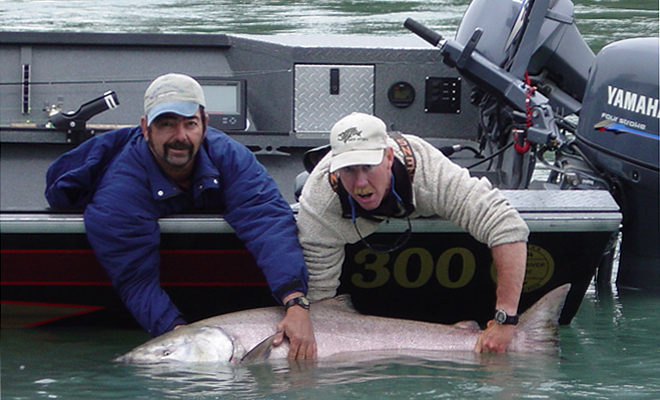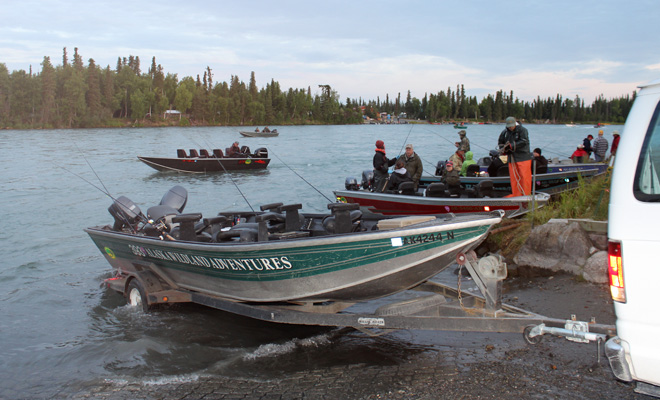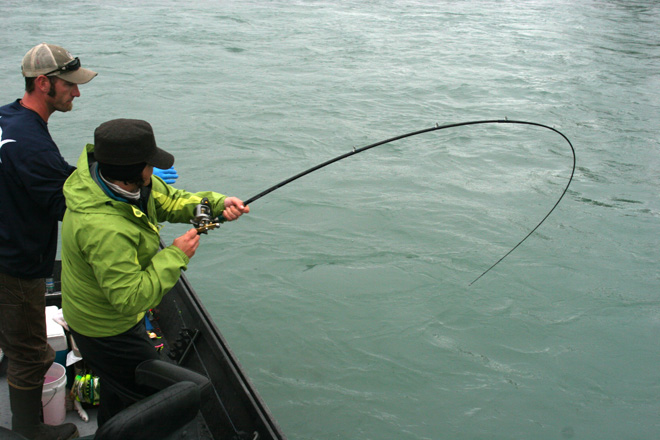
King Salmon
The name alone commands respect: King! But call it Chinook, tyee, blackmouth or any other, there is no doubt that it is the biggest and baddest of all salmon! And at the top of this list is the Kenai River king!
Nowhere else on the planet are there kings like in Alaska’s Kenai River. In fact, the world record 97 lb. 4 oz. and eight of the top ten hook and line Chinook ever officially documented came from the turquoise green waters of the Kenai River. Most kings return to their spawning river as three, four and five year old fish, but a small percentage of the genetically unique Kenai kings return as 6 and 7 year age-class fish; it doesn’t take a rocket scientist to realize that a salmon gorging itself on a protein rich diet of herring, squid and candle fish for 5 years in the ocean is going to be that much bigger than one that stays at sea for only 2 or 3 years. These coveted giants, hogs of 60, 70 and even 80 plus pounds, are what every serious salmon fisherman dream of!

Run timing for Kenai kings occurs May through July. (See Fish Alaska article Dec. 2005 “The Mighty Kenai: Run Timing”). The first Kings actually start in late April, when a few eager fish enter the low waters of the Kenai. Fishable numbers of Kenai kings occurs in mid-May, building day-to-day, until the “early run” peaks in mid-June. Historic midpoint of this run occurs somewhere between June 6 and June 20th, so naturally this represents a good time to fish these early run fish. Late June can offer slower fishing, creating a window between first and second run fish, but some mighty big hogs are often caught during this period by those willing to put in their time. July 1st marks the official start of the late run Kenai kings, but many years the fish counts (and consequently the quality of the fishing) does not ramp up until July 4-8th, again improving by the day until the historic peak, which normally occurs the last two weeks of July. (Note: king season closes on August 1st.)
Alaska’s fishing regulations are complex, to say the least, and while it is impossible to summarize them here, it is important to note that there are distinct differences in the regulations when comparing early run Kenai kings to late run Kenai kings. For example, during the May/June early run, the use of bait is prohibited and a slot limit requires the release of any Kenai king between 44-55 inches. Always review the regulations and/or consult ADF&G before fishing in order to remain within the law
Where to fish for these beasts is a complex subject, but it is interesting to note that some sections of the river are more productive than others. Although Kenai kings can be legally fished, and caught, in the middle river, the bulk of the fishing pressure for Kenai kings occurs in the lower 21 miles of river (see description of river sections on this website), especially during the busiest July season, and for good reason. While early run (May-June) fish are primarily spawners that are traveling upstream relatively fast, late run (July) kings are main-stem spawners that commonly travel slower and utilize the lower river and even tidal zones.

Catching a trophy Kenai king can be tricky, to say the least! The combination of big fish, fast water, substantial crowds and a wooded bank necessitate the use of a boat. While it can be done, landing a Kenai king from the bank is a highly unlikely event in all but a few select places. (Note: the Kenai river is no place for beginner boaters: sharpen your skills elsewhere and employ a seasoned operator or professional guide if you have not operated a boat on a fast, shallow, crowed river before!) With that said, actual methods employed are many, and largely a matter of personal preference.
Many locals and guides prefer to side drift a Spin ‘n Glow and fresh salmon roe, turning their boats sideways and casting their weighted offering up-river as the drift down, making light contact with the bottom. When they reach the bottom of the run or hole, they real up, run up river and drift through it again. Another very popular method is back trolling, where as the boat is held against the current and the lures (either a spin ‘n glow and egg combination or a large, wobbling plug such as a Luhr Jensen Kwikfish) are let out 35-45’ behind the boat. The operator gently lets the boat slip downriver in a slow and controlled fashion while the divers and plugs work the lower column of the river right next to the bottom. Rods are in rod holders or held very still while the angler awaits the hard and fast strike of a large Kenai king. The third commonly employed method for Kenai kings is called backbouncing (see the May 2002 Fish Alaska article “Backbouncing 101”) and it is perhaps the most challenging, and rewarding, way of catching Kenai kings. The operator handles his/her boat in a similar fashion to back trolling, lining up and holding against the current, while the angler lets their 3-12 oz. lead and spin ‘n glow/egg combo out behind the boat, making contact with the bottom then rhythmically lifting and setting, walking the bait down hopefully in the face of an aggressive king.
Regardless of how you fish kings on the Kenai, it is likely an experience you won’t soon forget. Just the opportunity to be on these sacred trophy waters inspires hope and dreams, knowing that you might be the next lucky angler to land a salmon of epic proportions!


